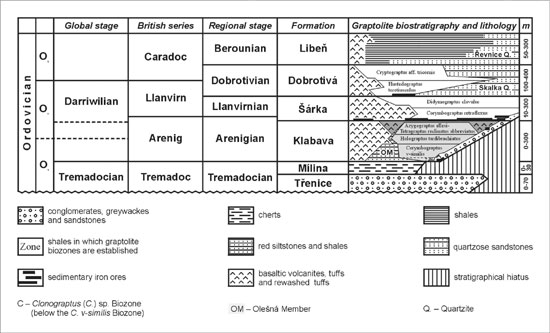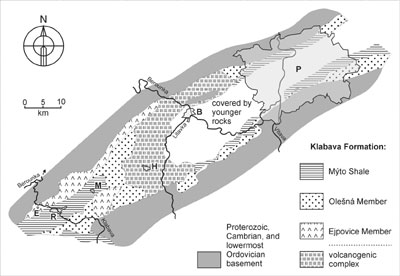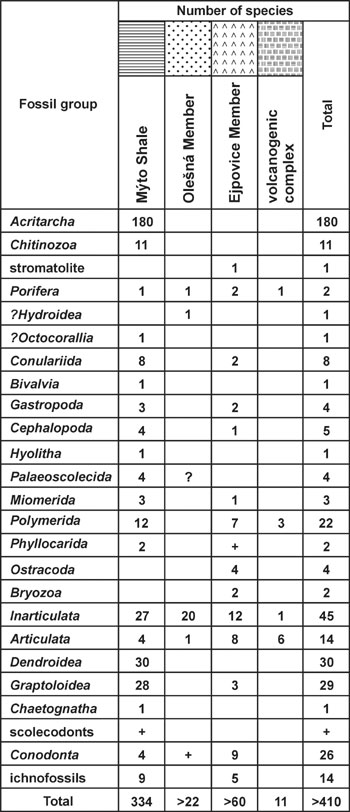
Facies of the Klabava Formation (?Tremadoc – Arenig) and their fossil content (Barrandian area, Czech Republic)
Petr KRAFT1 and Jaroslav KRAFT2
1 Charles University in Prague, Faculty of Science, Institute of Geology and Palaeontology, Albertov 6, 128 43 Praha 2, Czech Republic. E–mail: kraft@natur.cuni.cz
2 Museum of West Bohemia, Department of Palaeontology, Kopeckeho sady 2, 301 36 Plzen, Czech Republic. E–mail: jkraft@volny.cz
Key words: Facies. Lithostratigraphy. Fossils. Ordovician. Bohemia.
Introduction
The Klabava Formation (Figure 1) is a lithostratigraphic unit that was deposited in the Prague Basin (Barrandian area, Czech Republic). It is Arenig in age, but a local commencement of sedimentation in the uppermost Tremadoc cannot be excluded (Kraft et al., 1999). Its top is uppermost Arenig and there is no evidence for strata reaching up to the Arenig/Llanvirn boundary interval.
The Lower/Middle Ordovician boundary, as recently proposed, has to be placed within the Klabava Formation but its extact position is unknown because of lack of taxa which are useful for intercontinental correlations. Conodonts are rare and usually the stratigraphical value of taxa found is limited. Graptolites are abundant but they are usually endemic and/or long–ranging and hence, not suitable for exact correlations.
The Klabava Formation is conformably underlain by the Milina Formation. As the Milina Formation is considered to be a regressive unit, its lateral extension decreases in comparison to both, the underlaying Trenice Formation and the overlaying Klabava Formation. The latter has partly a transgressive character and covers not only the Trenice Formation but furthemore the Proterozoic (Cadomian) and Cambrian basement. It displays that the Prague Basin was a narrow sedimentary basin at the beginning of the Arenig. This basin extended gradually to the southwest. It probably spread also farther to the flanks of the Cambrian uplift area in the southeast and onto the Proterozoic peneplain during the Arenig.
The Klabava Formation is extended over the entire denudation relic of the Prague Basin. However, it is best exposed, and therefore best studied and best understood in the western part of the basin
The Klabava Formation is formed almost exclusively by clastic and volcanoclastic sediments. This fits with the general clastic character of the sedimentation of the Ordovician in the Prague Basin. In contrast to most other Ordovician formations in the basin, the Klabava Formation is widely differentiated into variable facies. These facies can change over short distances but general distribution relations are traceble. There is also a trend of an increasing amount of volcanoclastic components towards the top of the formation.

Figure 1. Stratigraphy of the Lower to the lowermost part of the Upper Ordovician of the Prague Basin (modified after Kraft et al., 2001). Olesna Memeber is labeled; Myto Shale is light grey shaded; Ejpovice Member is dark grey shaded.

Figure 2. Schematized distribution of members in the Klabava Formation. Volcanogenic complex illustrates the area of the Komarov Volcanic Complex during sedimentation of the Klabava Formation. Facies of pyroclastic rocks of the Klabava Formation is related to that complex. B, Beroun; E, Ejpovice; H, Horovice; M, Myto; P, Praha; R, Rokycany.
Members of the Klabava Formation
(For schematized geographic distribution see Figure 2)
Myto Shale. This member consists of clayey shales. It locally contains subordinated volcanic (tuffaceous) material, which the amount of which increases towards the top. Terrigenous, especially micaceous admixture can also be present. The colour of shales is usually greenish–grey or brownish–grey, but also grey to bluish–grey and locally dark grey to black shales have been observed.
This member includes facies of the so–called Euloma Shales defined by Holub (1911) and Didymograptus Shales defined by Havlicek and Snajdr (1957). The type section is Rokycany – Stran (the slope above the Klabava River from Klabavska stran to Kalvarie including localities such as Valcha, quarry, gully and others).
Ejpovice Member. This unit is composed of variegated rewashed tuffs and tuffitic shales. Some portions are laminated. Sedimentary iron ores (usually oolithic ores) occur locally. This memeber is developed in the uppermost part of the Klabava Formation. It has its greatest geographic distribution at the top of the formation. The type section of this member is in the former iron ore mine near Ejpovice (E and N banks of an artifical lake).
Olesna Member. This member was established by Kloucek (1917) and assigned to the Klabava Formation by Havlicek (1961). It is represented by red greywackes, siltstones and silty shales. The transgressive lower limit over the Trenice Formation is well exposed at Medovy Ujezd (e.g., Chlupac 1993), conform one at Milina (e.g., Mergl 1986).

Figure 3. Number of species of individual groups in the facies of the Klabava Formation. Patterns up in the collumns correspond to those in the Figure 2. Source data modifed after Kraft (1992).
Pyroclastic volcanosedimentary rocks related to the Komarov Volcanic Complex represent only a geographically restricted, local facies. Because of the lack of outcrops, no formal or informal lithostratigraphic unit can be established for this distinct facies at present time.
Comment to fossil content of the members and facies
Troughout the whole Klabava Formation, graptolites and inarticulate brachiopods dominate among the macrofossils (Figure 3). Both represent the most diversified and the most abundant groups . The high total number of trilobites is rather confusing because all species are very rare, except for their higher concentrations recorded in three localities. Because of the predominance of a few fossil groups combined with absence of stenohaline echinoderms and the low numbers of moluscs, especially cephalopods Kraft (1992) suggested that the lack of stenohaline organisms indicates lower salinity conditions (brackish/restricted sea conditions) in western part of the Prague Basin. (This interpretation cannot be applied in the eastern part of the Prague Basin because of lack of fossil sites.)
It is remarkable that the different members of the Klabava Formation contain distinct fossil assemblages. This was pointed out and described in general by Havlicek and Vanek (1966).
The most diversified fossil spectrum is preserved in Myto Shale. It contains remains of shelly faunas as well as an extraordinary soft–bodied fauna (e.g., chaetognaths). Fossil remains are of various original composition: organic (graptolites, chitinozoans, acritarchs etc.), phosphate (inarticulate brachiopods = linguliformeans in the Klabava Formation, phyllocarids, phosphatized palaeoscolecidans, etc.), carbonate (articulate brachiopods = rhynchonellyformeans, molluscs), and silica (sponges). However, graptolites and inarticulate brachiopods strongly predominate among macrofossils. This is a valid observation not only from a diversity point of view but also concerning to absolute number of specimens. It seems that this resulted from a non–favourable substrate and possibly other palaeoecological factors. Thus, only inarticulate brachiopods could live in or on clayey sediment and graptoloids floated in the water column above. Locally abundant dendroids had to be mostly transported from hard–grounds, which are supposed to exist and border the Myto Shale in long distances.
Ejpovice Member. Fragments of fossils possessing carbonatic (articulate brachiopods, bryozoans etc.), phosphatic (inarticulate brachiopods, conodonts etc.) and siliceous (sponges) skeletons have been almost exclusively recorded in this unit. There are almost no organic remains (each species of graptolites and hydroid have been found in single specimens of different preservations). This feature is apparently secondary.
Olesna Member. The only fossils in this unit are originally composed of phosphate and silica with the exception of one articulate brachiopod species. The absence of organic and carbonatic fossils is considered to be a taphomomic effect.
Facies of pyroclastic rocks related to the Komarov Volcanic Complex represent extraordinary local conditions in which fauna was rarely preserved. In spite of a distinct faunal assemblage, the only known occurrence does not offer sufficient data for detailed comparison with other facies of the Klabava Formation.
Conclusions
The Klabava Formation consists of several facies. Some of them characterize three defined members. The fossil contents of those members strongly differ. Even if it is undoubted that there were primary differences among assemblages of the members, preservational effects amplifies theses differences. This complicates palaeoecological analyses, reconstructions of environment, and correlations of members. On the other hand, these secondary taphonomic features are mappable and therefore contribute to recognition of these members as lithostratigraphical units.
It also should be emphasized that the preservational effects significantly influence the ability to do biostratigraphy, which is mainly based on graptolites in the Bohemian Ordovician. However, their use is restricted to the Myto Shale because graptolites are absent in the other members and facies. Chitinozoans and acritarchs, as potential stratigraphic tools in the Klabava Formation, are also organi–walled fossils and therefore have the same limitations. This complicates even the correlations within the Klabava Formation.
Acknowledgements
This contribution was finished with the financial support of the Grant Agency of the Czech Republic, project Nº 205/02/0934. It is a contribution to the project MSM Nº 113100006. Petr Kraft’s research benefitted from the support by the Alexander von Humboldt Foundation in the form of a fellowship and from joint studies with Oliver Lehnert supported by the same foundation (Feodor Lynen Fellowship). We are grateful to Oliver Lehnert and Stephen A. Leslie for their language corrections.
References
Chlupac I. 1993. Geology of the Barrandian. A Field Trip Guide. Senckenberg–Buch 69, Verlag Waldemar Kramer, Frankfurt am Main: 1–163.
Havlicek, V. 1961. Paleozoikum. In: Cepek, L. (Ed.), Vysvetlivky k prehledne geologicke mape CSSR 1 : 200 000 M – 33 – XX Plzen.
Havlicek, V. and Snajdr, M. 1957. Facialni vyvoj skidavu, llanvirnu a llandeila v Barrandienu. Sbornik Ustredniho ustavu geologickeho, oddil geologicky, 23 (1): 549–600.
Havlicek, V. and Vanek J. 1966. The biostratigraphy of the Ordovician of Bohemia. Sbornik geologickych ved, Paleontologie, 8: 7–69.
Holub, K. 1911. Nova fauna spodniho siluru v okoli Rokycan. Rozpravy Ceske akademie cisare Frantiska Josefa pro vedy, slovesnost a umeni, Trida II, 20, 15: 1–18.
Kloucek, C. 1917. Novinky z krusnohorskych vrstev d?. Cast II. Rozpravy Ceske akademie cisare Frantiska Josefa pro vedy, slovesnost a umeni, Trida II, 25, 34: 1–28.
Kraft, P. 1992. Ekostratigrafie klabavskeho souvrstvi (ordovik) v zapadni casti prazske panve. Unpublished PhD thesis, Univerzita Karlova v Praze, Praha: 1–190.
Kraft, P, Kraft, J. and Prokop, R.J. 2001. A possible hydroid from the Lower and Middle Ordovician of Bohemia. Alcheringa, 25: 143–154.
Kraft, P., Kraft, J., Fatka, O. and Seidl, R. 1999. Nejstarsi zastupce radu Graptoloidea z barrandienskeho ordoviku a jeho stratigraficky vyznam. Zpravy o geologickych vyzkumech v roce 1998: 58–59.
Mergl, M. 1986. The Lower Ordovician (Tremadoc–Arenig) Leptembolon Community in the Komarov Area (SW part of the Prague Basin; Bohemia). Folia Musei rerum naturalium Bohemiae occidentalis, Geologica, 24: 3–34.
Received: February 15, 2003
Accepted: June 15, 2003